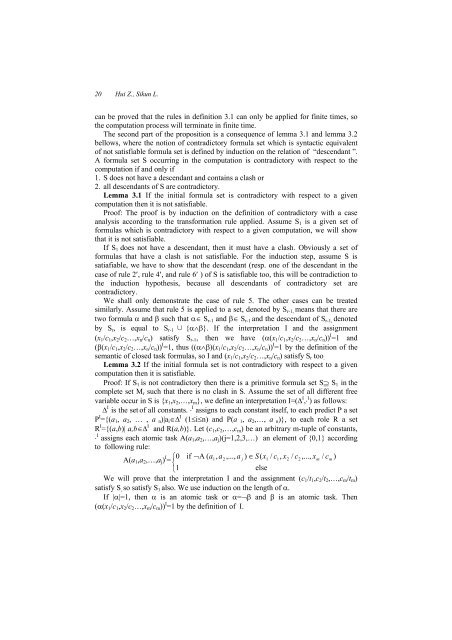Advances in Artificial Intelligence Theory - MICAI - Mexican ...
Advances in Artificial Intelligence Theory - MICAI - Mexican ...
Advances in Artificial Intelligence Theory - MICAI - Mexican ...
Create successful ePaper yourself
Turn your PDF publications into a flip-book with our unique Google optimized e-Paper software.
20 Hui Z., Sikun L.<br />
can be proved that the rules <strong>in</strong> def<strong>in</strong>ition 3.1 can only be applied for f<strong>in</strong>ite times, so<br />
the computation process will term<strong>in</strong>ate <strong>in</strong> f<strong>in</strong>ite time.<br />
The second part of the proposition is a consequence of lemma 3.1 and lemma 3.2<br />
bellows, where the notion of contradictory formula set which is syntactic equivalent<br />
of not satisfiable formula set is def<strong>in</strong>ed by <strong>in</strong>duction on the relation of “descendant ”.<br />
A formula set S occurr<strong>in</strong>g <strong>in</strong> the computation is contradictory with respect to the<br />
computation if and only if<br />
1. S does not have a descendant and conta<strong>in</strong>s a clash or<br />
2. all descendants of S are contradictory.<br />
Lemma 3.1 If the <strong>in</strong>itial formula set is contradictory with respect to a given<br />
computation then it is not satisfiable.<br />
Proof: The proof is by <strong>in</strong>duction on the def<strong>in</strong>ition of contradictory with a case<br />
analysis accord<strong>in</strong>g to the transformation rule applied. Assume S 1 is a given set of<br />
formulas which is contradictory with respect to a given computation, we will show<br />
that it is not satisfiable.<br />
If S 1 does not have a descendant, then it must have a clash. Obviously a set of<br />
formulas that have a clash is not satisfiable. For the <strong>in</strong>duction step, assume S is<br />
satiafiable, we have to show that the descendant (resp. one of the descendant <strong>in</strong> the<br />
case of rule 2′, rule 4′, and rule 6′ ) of S is satisfiable too, this will be contradiction to<br />
the <strong>in</strong>duction hypothesis, because all descendants of contradictory set are<br />
contradictory.<br />
We shall only demonstrate the case of rule 5. The other cases can be treated<br />
similarly. Assume that rule 5 is applied to a set, denoted by S r-1, means that there are<br />
two formula α and β such that α∈ S r-1 and β∈ S r-1 and the descendant of S r-1, denoted<br />
by S r , is equal to S r-1 ∪ {α∧β}. If the <strong>in</strong>terpretation I and the assignment<br />
(x 1 /c 1 ,x 2 /c 2 …,x n /c n ) satisfy S r-1 , then we have (α(x 1 /c 1 ,x 2 /c 2 …,x n /c n )) I =1 and<br />
(β(x 1 /c 1 ,x 2 /c 2 …,x n /c n )) I =1, thus ((α∧β)(x 1 /c 1 ,x 2 /c 2 …,x n /c n )) I =1 by the def<strong>in</strong>ition of the<br />
semantic of closed task formulas, so I and (x 1 /c 1 ,x 2 /c 2 …,x n /c n ) satisfy S r too .<br />
Lemma 3.2 If the <strong>in</strong>itial formula set is not contradictory with respect to a given<br />
computation then it is satisfiable.<br />
Proof: If S 1 is not contradictory then there is a primitive formula set S⊇ S 1 <strong>in</strong> the<br />
complete set M r such that there is no clash <strong>in</strong> S. Assume the set of all different free<br />
variable occur <strong>in</strong> S is {x 1 ,x 2 ,…,x m }, we def<strong>in</strong>e an <strong>in</strong>terpretation I=(∆ I ,⋅ I ) as follows:<br />
∆ I is the set of all constants. ⋅ I assigns to each constant itself, to each predict P a set<br />
P I ={(a 1 , a 2 , … , a n)|a i ∈∆ I (1≤i≤n) and P(a 1, a 2 ,…, a n)}, to each role R a set<br />
R I ={(a,b)| a,b∈∆ I and R(a,b)}. Let (c 1 ,c 2 ,…,c m ) be an arbitrary m-tuple of constants,<br />
⋅ I assigns each atomic task A(a 1 ,a 2 ,…,a j )(j=1,2,3,…) an element of {0,1} accord<strong>in</strong>g<br />
to follow<strong>in</strong>g rule:<br />
A(a 1 ,a 2 ,…,a j ) I =<br />
⎧0 if ¬ A ( a<br />
1,<br />
a2<br />
,..., a<br />
j<br />
) ∈ S(<br />
x1<br />
/ c1,<br />
x2<br />
/ c2<br />
,..., xm<br />
/ cm<br />
)<br />
⎨<br />
⎩1<br />
else<br />
We will prove that the <strong>in</strong>terpretation I and the assignment (c 1 /t 1 ,c 2 /t 2 ,…,c m /t m )<br />
satisfy S , so satisfy S 1 also. We use <strong>in</strong>duction on the length of α.<br />
If |α|=1, then α is an atomic task or α=¬β and β is an atomic task. Then<br />
(α(x 1 /c 1 ,x 2 /c 2 …,x m /c m )) I =1 by the def<strong>in</strong>ition of I.

















